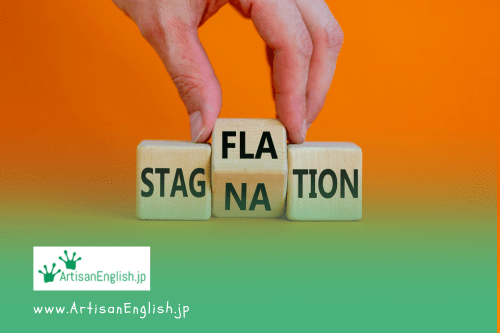
YouTube / iTunes / Spotify / Radio Public / Pocket Casts / Google Podcasts / Breaker / Overcast
Listen to ArtisanEnglish.jp posts & lesson intros here.
Word of the Day: Stagflation
Today, we are going to get into some economic terminology.
Let’s talk about stagflation.
Stagflation is an economic condition characterized by three main factors: stagnant economic growth, high unemployment, and high inflation.
This unusual combination creates challenges for governments and policymakers, as traditional methods to combat inflation can worsen unemployment and vice versa.
We’ll look into stagflation because Donald Trump’s tariffs may cause some nations to suffer from stagflation.
In simple terms, stagflation occurs when the economy is not growing, but prices keep rising.
This situation is frustrating for consumers because they may have no job and face increasing costs for everyday items.
For example, during a period of stagflation, groceries and gas become more expensive, but many people struggle to find work.
Stagflation became widely understood during the 1970s when several countries faced this troubling economic environment.
Back then, economists were puzzled because the usual policies that worked during inflation or a recession were not effective against stagflation.
As inflation continued to rise, it became clear that without growth, the situation could get worse.
To combat stagflation, consumers must focus on budgeting and prioritizing essential expenses.
Meanwhile, governments have to look for innovative solutions to stimulate growth without adding to inflation.
Understanding the causes and consequences of stagflation is crucial for those studying economics and for everyday citizens trying to manage their finances.
By recognizing the signs of stagflation, we can prepare for its impact and better navigate our finances.
Being informed about stagflation can help us understand and respond to challenges in our economy.
Flesch-Kincaid Readability Test
This post is likely to be understood by a reader who has at least some college education.
On the Flesch-Kincaid reading-ease test, this post scores 38.
The easier a passage is to read, the higher the score on a scale of 0 – 100.

